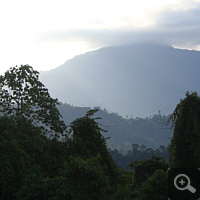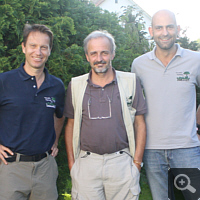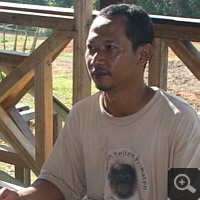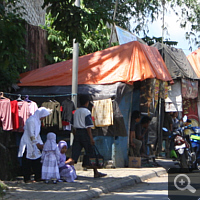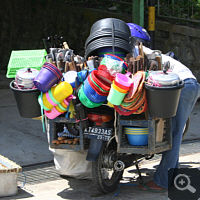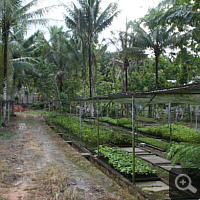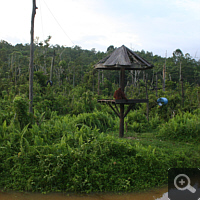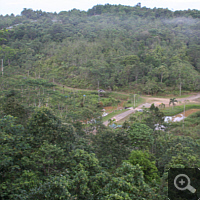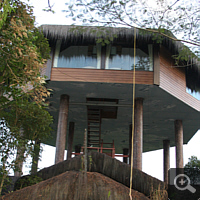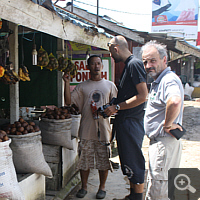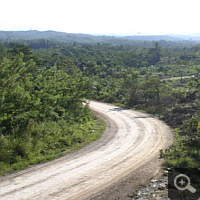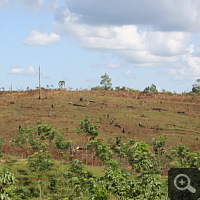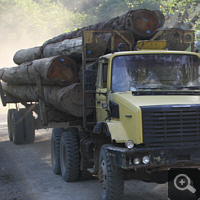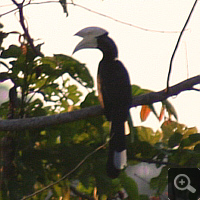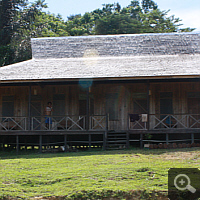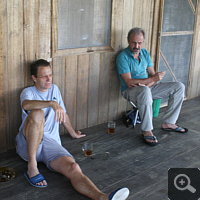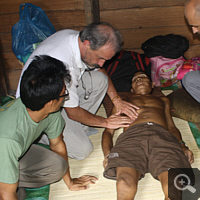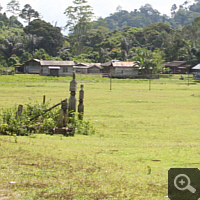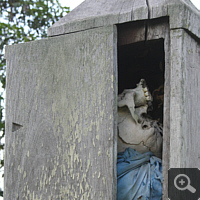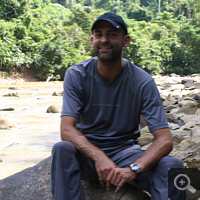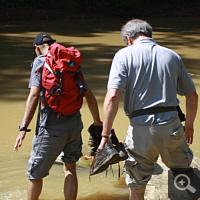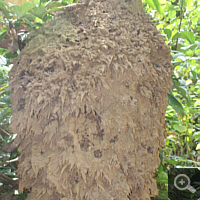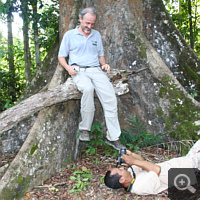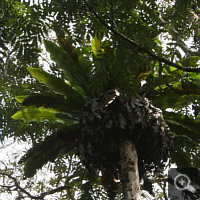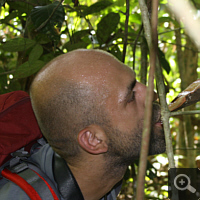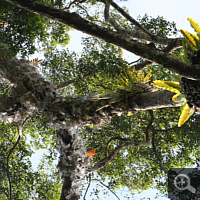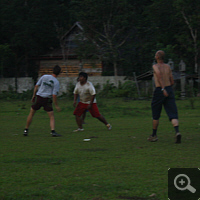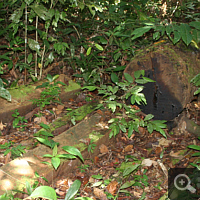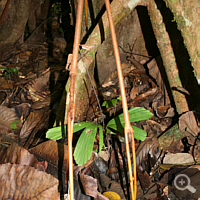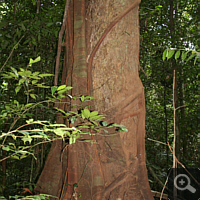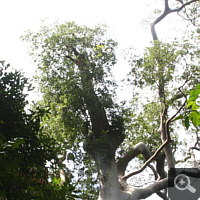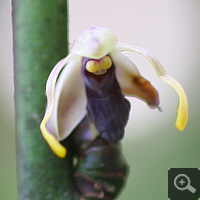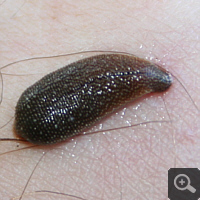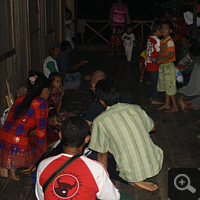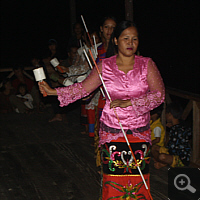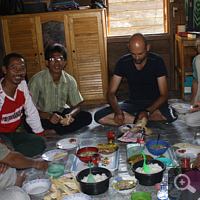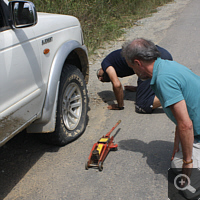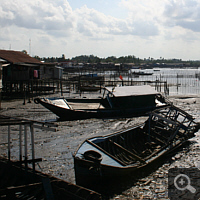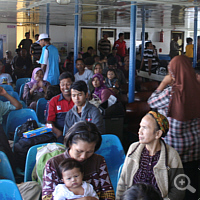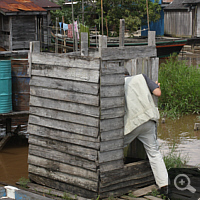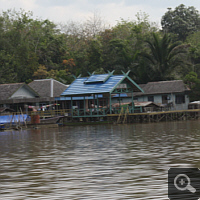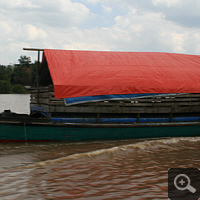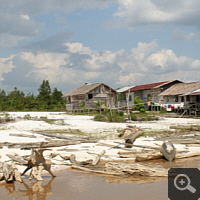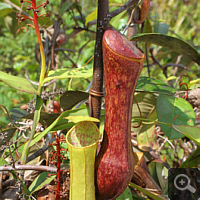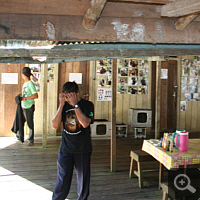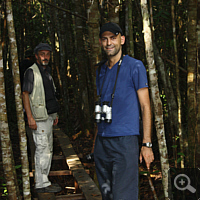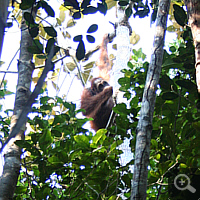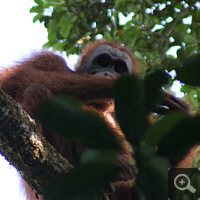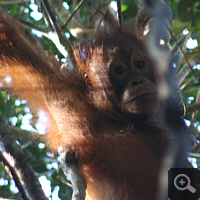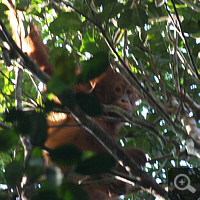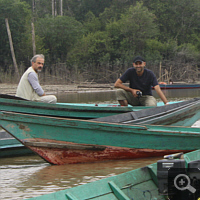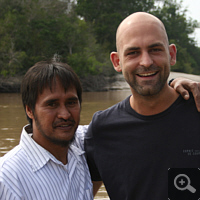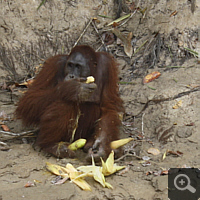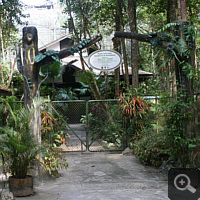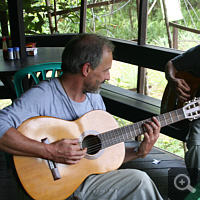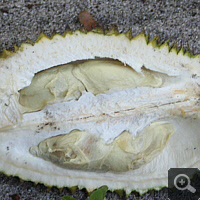
Travelog Borneo journey 2011
Gentle reader.
I want to prepend this travelogue a brief remark. Contrary to the present concept of this homepage, which is featured strongly scientifical and facts-oriented, I have intentionally written the following travelogue about my Borneo tour rather emotionally and impressionistically, because this tour has affected me intensely.
That who expects a strong fact-oriented travelogue – best with GPS position information, will be disappointed. This travelogue is aimed at those who want to get conveyed a holistic sight of Indonesia. A sight with impressions of the country, its residents, its flora and fauna, as well as its endangerment.
Prologue
Doubtless it didn’t escape the notice of the gentle reader of my website, that I am passionate hobby-botanist. Thus I conceive for a considerable time the desire to go on a journey into the tropics – more precisely into a tropical rainforest.
I am a physician and became acquainted with a new colleague in my hospital, namely Bernhard. At first Bernhard studied biology. Later he founded the Verein Faszination rainforest e.V., which espouses preservation of tropical rainforests. In Indonesia, was together with the German association fansfornature e.V. the Alas lou taka Foundation initiated, which especially espouses preservation of one of the few remaining lowland rainforests in Southeast Borneo, the Meratus region. When Bernhard told me about his project, it was immediate obvious to me, that I will accompany him there.
Our tour group was completed by Thomas, a further colleague. Thomas is my very intellectual and copious interested senior physician.
Ride into adventure (day 1, 26.06.2011)
At last, today is the day. The journey is setting in. For months I was champing at the bit to this moment. So far I was full of anticipation and excitement. After I have packed my bags ready, also other emotions stalk me for the first time. From excitment becomes tension, likewise the worries are growing. Am I prepared for all, didn’t I forget anything? Will I come well through the days within the rainforest? Quickly these easy doubts make way for excitement for the next days.
We meet us at Bernhard and continue driving to the Munich Airport. Then, short time later we sit within a Lufthansa airbus. I feel a bit empty. After a long study of literature and the occupation with the topic of nature preservation, the trip is beginning into a region, which is characterized by severe destruction and which could conserve only fragmentary its faunistic and floristic values. What will the impressions cause with me?
Arrival in Indonesia (day 2, 27.06.2011)
I was scared of the long-distance flight. But due to a sleeping pill I overslept this for the most part and awoke only just before the stopover in Singapore. After a short stop there, the trip proceeded with a connecting flight to Jakarta.
On leaving of the airport terminal of Jakarta an unaccustomed mixture of muggier heat paired with the smog of the million-juggernaut Jakarta beat me. We spend our first night in an international transit hotel, which we share with American surfers and Indonesian businessmen. We converse at dinner a while longer about the following days and enjoy for the moment the last western culinary delicacies.
Finitely in Borneo (day 3, 28.06.2011)
After a western-continental breakfast we start out to our onward flight to Borneo. The transfer with the hotel-shuttle-bus is the first contrary program to the impressions of Indonesia so far, which are modest indeed. Because these are confined to the airport of Jakarta by night and a modern hotel with freshly squeezed juice and wellness section.
The drive leads through the slums of Jakarta. You can see barely assembled corrugated sheet cottages and a garbage contaminated landscape. It becomes apparent once more, how unhomogeneous the capital worldwide is distributed – belong to the richest people worldwide yet not only occasionally Asians.
A phenomenon is the traffic in Indonesia, which could easily be used as evidence for self-assembled processes. For the outsider appears this as pure chaos. No traffic signs, no traffic lights. In addition to trucks and buses you can see numerous cars.
However, the dominating means of transport are mopeds, which like a flushed swarm of bees scrape by through the slow-flowing traffic on the left and on the right. Partly these mopeds carry whole families including sleeping babies, other mopeds are adventurously as driving mom-and-pop shop packed. What kind of effects for nature, for the consumption of resources and for the oil price it will have, as soon as the mopeds of the emerging and newly industrialised countries bit by bit by cars will be replaced?
From Jakarta we fly farther to Balikpapan, which is in Southeast Borneo. There we are received by Bernhards Indonesian friends. On the one hand that is pak Fredy, an Indonesian businessman with very good command of English and a good knowledge about the Western world. In the last few years he evolved into an important frontman in the struggle for the beauties and valuables of his home island and is in the meantime chairman of the Alas lou taka – Foundation. On the other hand pak Satriyo welcomes us. Pak Satriyo is studied botanist and should be our accompaniment for the next days. At that moment it is not clear in my mind, how much this bustling, small Indonesian will grow dear to my heart, so that I will count him at the end of our journey as a friend.
In the first instance we drive in the village Samboja a bit western of Balikpapan. There is situated a little tree nursery of the Alas lou taka – Foundation. The seedlings, which are raised here, should be used later for reafforestation in the area of the Meratus – protection forest margin. The proof, that a reafforestation can work in the medium term, is to be found only a few kilometres away. We visit the project Samboja Lestari. On a area of 1.800 hectares BOS, an organisation about which I later will tell more, runs a species-rich reafforestation since 2001.
I perceive the drive through this secondary rainforest as impressing. Within circa ten years the forest grew up in some places to more than 15 metres height. In the middle of the forest tracks a small river with several islands. These serve affected with hepatitis C, from captivity coming orangutans as last refuge.
After a cool beer in the Samboja Lodge at a wonderful panorama we return played out late in the evening in our hotel in Balikpapan.
Against human reason (day 4, 29.06.2011)
It is a considerable day for us. Today we travel into an intact lowland rainforest. This is located western of Balikpapan around Mount Meratus. The rainforest is a protection forest of a size of 28.000 ha, in which no logging by the three great logging companies, which are active in Borneo, occurs. We will take up our quarters in the small Dayak-village Tanjungsoke, which is located on the verge of the protection forest.
At first we drive circa 100 km to the west till the village Satek. At the roadside are to be found barely constructed cottages, oil palm plantations and diverse street hawkers, who offer diverse fruits. I can not resist, so that we stop and I buy apart from salaks (this is a palm fruit with brown, snakeskin-like skin) one jackfruit (the greatest edible fruit worldwide).
In Satek we branch off on a gravel track, which was built by one of the great logging companies and which leads deeply into the interior of the country. At first the roadsides are characterized by diverse single-crop farmings. Thereby it mainly concerns banana, pepper and oil palm plantations.
Doubtless the most important factor for the worldwide decrease of rainforests is the deforestation for the export of tropical timbers as teak or ironwood. In addition also fires, deforestation for the production of raw materials (in Borneo this is mainly opencast coal mining) and the cultivation of oil palms play a crucial role. It is a parodox. Where a few years or decades ago an intact lowland rainforest stood, line now great oil palm plantations the logger dirt road. Oil palms, whose fruits in Europe are among other things manufactured into „biofuel“!
Time and time again gigantic dustclouds float across the rough gravel track. Whose cause are giant logging trucks, which have loaden almost a dozen of teak or ironwood trunks. Each of these trucks has loaded hundreds years of growth. Tremendous jungle giants are wrested from ecosystem to be manufactured in the Western world into noble parquet floors or premium inventory. Thereby the damage confine itself not „only“ to the felled jungle giants. To cut down these colossi and to dispatch them heavy device is necessary, which causes damage itself. Each falling jungle giant strikes a swath of destruction into the forest and not least with the felled trees the particular epiphytes get also lost. At last the remaining forest is burnt down to use these areas for plantations. Each approaching transporter is for me like a stab into my small botanist heart!
The gravel track seems to go on forever. Because we are almost at the equator, shortly after 17 o’clock the dusk is approaching. It is Satriyo, who rouses me in this moment with the sudden cry of astonishment: „Look, there are hornbills!“ from slumber and points us to our first zoological speciality. Indeed, in this moment two great birds, namely hornbills, overfly us.
This bird species is very rare in the meantime. They depend on an intact rainforest in some degree, because they accept breeding burrows only in a height of 20 m upwards. Hornbills especially live on figs, but also do not disdain insects. Characteristic is their giant bill with a horny attachment. In spite of its size the bill is very light, because it consists of a beam-like tissue. About the function of the horny attachment exist several theories. Most probable is a function as sound box, another theory assumes a function as air conditioning system, with which hornbills evolve abundant heat.
Shortly afterwards we see a hornbill again. We are favoured by fortune. When we get off our car this exemplar does not fly away. It allows us to watch its every step with the binoculars for minutes and to take a photograph of it in the dusk with the telephoto lens. Later I will determine this species as Great Hornbill (Buceros bicornis). When the bird flies away, rings out the for hornbills characteristic wing beat, which is something evocative of a starting steam locomotive. What a fantastic natural spectacle: A species, which you only knew from zoo visits up to now, to experience in the wild.
After 100 km logger dirt road we achieve finally the village Deraya, a loose settlement, in which we turn and embark us on the last ten adventurous kilometres into the Dayak-village Tangjungsok, which is located on the verge of the Meratus-rainforest and in which we will live the next days.
We arrive at darkness and move into our lodge, which was built by a German carpenter a few months ago. I am thunderstruck by the lodge. It does not fit my expectations of a simple wooden hut in the nowhere with an overnight stay on a camping mat under a mosquito net. Instead of that we come upon four rooms. Each room is equipped with two roosting places, in each case with a kind of simple duckboard. Any more I am surprised at the existence of a gas cooker and of sanitary installations. Western toilets with running water.
After we have moved into our lodge, we visit the village. There we – respectively Bernhard, who has, as I have already at the outset particularised, a deep closeness to Tanjungsoke – are wistfully expected. It follows a nice small talk at rice, fish and vegetables. In the traditional way the dinner is taken sitting on the floor.
An unique ecosystem (day 5, 30.06.2011)
The night was pretty mediocre. The muggy heat within the forest with a humidity as much as 100%. Moreover this damned mosquito net, in which I have entagled me more than any mosquitoes. I will not die of malaria or dengue fever. But awake one morning like a struggling insect in a spiderweb?
The coffee together with the spledid view to the rainforest from the porch of the lodge, which is built on a slight hill, let perk up me qickly. In a couple of hours we will explore this rainforest.
At first we have to work. Naturally it has got around quickly in the village, that two doctors are staying in the village at the moment.
Interest is keen because a medical care of the village quasi does not exist. The next doctor is situated 100 km away, furthermore most village residents can not raise required funds for a trip there, much less for the doctor’s fee.
On the one hand it goes without saying to help as doctor on site, on the other hand this goodwill can regard as confidence-building measure to be conducive to a future cooperation between the Alas lou taka Foundation and the village residents. An adequate communication is granted with Pak Satriyo as interpreter. At first scepticism prevails, the village residents only hesitantly lie down for examination on the floor of the mayoral cottage. Bit by bit we gain their trust, so that we are consulted all in all by circa a dozen patients. Most disease patterns are not of serious nature and can be well treated by some drugs from our first-aid kit.
We have an appointment with our guide through the rainforest first in the afternoon. Thus we use time for the first exploration and relax program. The walk through the village is definitely not uninteresting. Most Dayaks have left their villages and are living in the meantime in scattered settlements along the logging dirt roads. Tanjungsoke is one of the few classic Dayak villages with an intact social structure. The simple wooden cottages stand around a central multipurpose village square, which is used by the water buffaloes as field as well as by the village residents for soccer playing in the evening.
A small river with the name Bongan passes off the village in a distance of circa 30 m. Now during dry season it leads only a few clay-yellow water. Within the river great stones lie scattered. Water level fluctuates depening on the site between 30 and 180 cm.
Nevertheless I decide on a bath within this rainforest river. After some wounds I have finally found a site of circa 20 m length, in which I can swim with my body size relative trouble-free. Bathing in the river is simply delightful. At the back adrift in over 20°C warm water with a vertical over one standing sun, the riverbanks lined by tropical forest. Now and then a three-boys-gang in the age of circa 3 – 6 years attracts my attention. This touch with nature! They bustle elegant around over the soggy rocks at the riverbank to fish barehanded small crabs out of the river – out of a sludge, in which you see into no 2 cm deep. In this moment I have to think about my previous unsecure steps over just these soggy rocks. The short bath in the river lasts after all over one hour.
In the afternoon we set off together with pak Satriyo and a guide from the village to a tour into the rainforest. The rainforest lies on the other riverside, so that we have to cross the river at first. Then our trail winds uphill at first through a secondary rainforest (For interested readers I have composed here a detailed site about tropical ecology.), then passing wild varieties of the salak palm as well as liana-like rattan plants. Both are equipped over and over with scary spines. The way continues passing termite mounds and remaining jungle giants like the ironwood tree and different meranti species.
The deeper we push forward into the forest, the more the secondary rainforest merge into a little disturbed primary rainforest. Already a cursory glance into the forest brings this difference home to one’s mind. As the secondary rainforest was an impenetrable scrub, through which you had to slash yours way with a machete, whereas in the primary rainforest a rather sparse undergrowth becomes apparent. In aspect the primary rainforest is similar to a German beech forest in summer. Like in a beech forest only very little sun light reaches the ground (in the tropics circa 1%), so that can prosper only a few specialists there. Who is the opinion you see in a rainforest a sea of blossoms and also triads of insects, snakes and birds, that one will be disappointed.
In fact you can see except jungle giants pretty nearly nothing, as long as you are moving on the forest floor. Nevertheless at this point of the trail the hundreds years old jungle giants are an impressive sight. Many trees show gigantic buttressed roots of several metres height and length. Trees produce buttressed roots in the course of their growth. Most rainforest trees are shallow-rooted plants, so that for a secure anchorage buttressed roots are produced.
At last we get around to the solution of the putative contradiction of my descriptions contrary to the common knowledge about extreme species-rich tropical rainforests. Proper life takes place two floors further up within the rainforest. To escape light deficiency at the forest floor and to can run an efficient photosynthesis, most plants are sitting on the top of the jungle giants. Such mounting plants are called epiphytes. Unlike in the case of the German mistletoe epiphytes do not damage the trees, they do not live parasitic.
If you risk a look upwards, you can see that the branches of the jungle giants are covered over and over with plants. This community of plants is mostly composed of diverse fern, bromeliad and orchid species. Corresponding to the flora also the fauna has shifted in the course of evolution the centre of its life into the canopy of the rainforest.
After almost two and a half hours we return from the rainforest back to the village, where already the every evening soccer match is taking place. Bernhard and I take part in this match, but are not really equal to the well-conditioned guys.
Big jungle party (day 6, 01.07.2011)
Today we start already in the morning in the rainforest. As yesterday the trail leads at first through the river and then through secondary rainforest before we arrive at another part of the primary rainforest.
Here and there pak Satriyo explains a lot about the interrelations of the Dayaks with the rainforest. At this place the primary rainforest is mainly dominated by three tree genera. Most frequent are diverse meranti species, the main victim of the wood cutters. Their wood is manufactured into veneers and weatherproof window frames. In addition ironwood trees and honey trees (Koompassia excelsa) arise more frequent. Both species are adored by the Dayaks for different reasons. Ironwood trees produce an extrem dense and therefore consistent wood. This consistency makes them to a coveted aim of wood cutters.
On the other hand ironwood trees because of their pressure resistant wood the only one tree species, which regularly concludes successfully the duel between tree and strangler fig. The seeds of strangler figs gain branches with the bird’s dirt. There they germ and lead initially an innocent epiphytic existence. Later the strangler fig starts to produce roots, which grow stem-downwards to the ground. Once the roots have reached the ground, more and more faster additional roots are produced until the host tree is finally completely encased and dies. The host tree is decomposed for decades. At the end remains only an inside hollow strangler fig.
The so-called honey trees are very imposing appearances. Honey Trees are up to 75 m tall jungle giants with a lightish, smooth bark. They belong to the papilionaceae family. High up in the forked branches wild bees construct their beehives, of which a full grown honey tree can host as many as 50 exemplars. Each Dayak man „possesses“ his one honey tree, whom he periodically climbs upwards unsecured with only a self-made rope, to pick the honey.
Close by our resting spot after a circa three-hours hike we have luck. One of the jungle giants lies disrooted in front of us. For the first time we come into range of epiphytic growth. The first orchids!
A while later we take a second break in a small creek bed. A really idyllic place: Pure water, through which drift swarms of small fishes. From the creek bed emanates a comfortable fresh. In general, air is marvellous here. Roundabout almost untouched primary rainforest with irregularly sounding cicada orchestra.
Abrupt the idyll is penetrated by Thomas’ bloody trousers. Both trouser legs are cluttered with great bloodstains. Somehow he looks like he just would have a battle with a porcupine. However, the cause is significant smaller. There are some leeches. These sojourn on the moist leaves on the ground and are probably climb vertically through the below open trouser legs. In the meantime some have probably departed full as a tick. Witnesses of attack are one remaining leech and the after-bleeding from several bite points. I am also not been spared and host of these rainforest vampires. They are not hard to remove, but in a sort mysteriös and whizzy. I have perceived nothing, so nothing at all, not even a short stitch.
For the evening a littel party is announced, because the older ones in the village the presence of strangers is a welcome opportunity to celebrate old rituals and customs again. At least the half village has come together at the porch of our lodge. Preparations are running. Musical instruments are rigged up. One of these is like a mixture of talking drum and jungle drum set. A wooden frame construction, in whose single compartments metal sounding boxes are brought in, which looks more or less like inverted pots. The dancing girls adjust their costumes. Among the children is just being foughten out the seating arrangements. But as in Germany too: Business before pleasure. Evidently our yesterday’s behavior was confidence-building. Pak Satriyo asks, if we could to examine one patient or two. We barely agreed, the first patient is lying on the porch floor, lined by the remaining, sitting village community.
Probably the desire for privacy is here less marked than in our country. After from one patient or two have become way more than ten patients, also the preparations are thriven so far as the party can begin.
To rhythmic sounds five festally dressed dancing girls perform several dances. With the one hand they move fitting to the beat a rattle, with the other hand they move a colourful stick. I am total fascinated by their footwork, however, I have not too long time to study these, because after some dance rounds Thomas and I are called upon to take part. Our footwork is not nearly thus graceful, so that we become still fairly quickly to an amusing element. Nevertheless it is a tremendous fun.
Among Indonesians (day 7, 02.07.2011)
I awake with mingled feelings. A three-day diet consisting of omelette, rice and some vegetable for breakfast, lunch and dinner wasn’t easy for me.
Nevertheless I have regrets that we leave today. In the rainforest it still would give so much to discover. Furthermore Tanjungsoke is a pleasant village with likeable residents. I could dwell here with pleasure some days. Swim in the river, play soccer, escape the fast moving daily routine of the Western world. In spite of the simple living conditions the village community seems for me as foreigner pleased with life. How will evolve this Dayak village in the future? I believe globalisation will clutch also here. The first Dayaks have a mobile phone. Not less than each second cottage is media connected via satellite dish with the whole world. Will the local youth stay there or its (perceived) happiness of life seek in the wide world – will the village increasingly become an orphan? How will change village community?
Instead of as with the arrival to drive round the Balikpapan bay, we cross this time the bay via ferry. On the way to the ferry terminal we are briefly held up by a flat front tyre. However, in teamwork the tyre change is done within a few minutes.
On the ferry two impressions become more intense, which I already got some days before. The southeast of Borneo appears to be a foreigner free zone. I saw the last Non-Indonesian in Jakarta. Apart from that Indonesia seems to be a gold mine of the tobacco industry. Perceived the smoker rate seems to be over 80%. Even on the ferry everywhere is being smoked. A smoke-free zone doesn’t exist. In fact the kiosk staff smoke behind the counter.
In Balikpapan we are free in the evening, so that I use the time for a visit of a shopping mall. From the outside it didn’t appear for me as very great, but the inside makes itself out to be gigantic. That regards both the dimension and the offer. From gym equipment and the recent mobile phones is all being offered up to travels to the Bahamas. You gain a complete contrary impression to the roadsides a few kilometres outside of the centre. Balikpapan seems total obviously to profit from local abundance of natural resources (fossil oil and coal).
I am looking for books about the Indonesian flora. Unfortunately I can count my Indonesian vocabulary at five fingers. Although I don’t address in the whole shopping mall one Indonesian, who masters more than three words English, we can communicate to each other with hands and feet at the end. The Indonesians are a very polite and helpful nation.
And it strikes me once more, how attractive the female Indonesians are.
About forest people and curious plants (day 8, 03.07.2011)
To start off with: it will become a splendid day. Today we fly from Balikpapan farther to Banjarmasin. Pak Satriyo will not accompany us, so that now is the moment to take farewell. I will truly miss this guy. For me he was not only a guide and interpreter. I found his heterogeneous personality structure very pleasant. Knowledge (both botanical and information technological) and cooperativeness paired with creativity and spontaneity: marvellous.
At the airport of Banjarmasin we are received by pak Odom, pak Apri and pak Rahmadi. At first we drive over several hours using bad roads to Mantangai. On the way there we come round at fruit stands once again, which I can not resist. Among other things I buy a Durian. This is a quite curious fruit. A Durian has the size of a watermelon and a spiky skin. The most important thing is its smell though. This is almost not to put into words, somehow sulphureous. In short, it smells tremendously. Therefore I attract the complete displeasure of my German friends, who will have to suffer the smell of the Durian the whole day.
From Mantangai we go on with a speedboat upstream the Kapuas river up to the secluded village Tuanan. Two reasons lead us to go there. On the one hand Bernhard want to build together with three other German organisations a school within this poor village. On the other hand one of the few preserved swamp rainforests of Borneo is situated in the close proximity of the village.
This swamp rainforest is the habitat of still circa 3.600 wildlife orangutans and of ten different pitcher plant species. Pitcher plants (Nepenthes) are perennial, partly some metres high shrubs with very whizzy leaves. The putative leaf is a broadened leafstalk, viewed in a botanical light. The proper leaf itself is converted into a tubular to cup-shaped trap, with which the plants mainly insects, but sometimes also frogs or small animals, capture and subsequently with the aid of enzymes digest. Pitcher plants are thus carnivorous plants.
Actually the village Tuanan could convey a wonderful view. Scattered standing cottages direct at the Kapuas river. Between the cottages and up to the riverbank finest, white sand. Actually dreamlike, if the sand would not be littered all over with waste.
From the village we set out for a circa two kilometres long ramble to the swamp rainforest. Already a little distance outside of the village we discover the first pitcher plant species, which upheave themselves gracefully liana-like at the shrubs. From the shrubs the colourful traps hang like balls at the Christmas tree. The way goes past at a several hectare large area of destroyed rainforests. In Borneo late-nineties severe forest fire rampaged, to which also this area falled victim. Finally we arrive in the margins of the swamp rainforest in a little camp, from which pak odom together with his employees research the orangutan population.
A handful orangutans, which have their territory in camp proximity, names were given. At the wooden walls of the camp different photo galleries are to be found: Sorted by sexes, in each case expressional photos marked with names.
From the camp a miles long wooden pathway, which consists of two small boards, leads deeply into the dark forest. Now during the dry season, which is anyway very distinct this year according to pak Odom, this wooden construction would be redundant, however, during the rainy season the forest is periodically overflowed.
Again and again we discover on the left and on the right of the trail new pitcher plant species, but the further we push forward into the forest, the more I abandon hope to discover an orangutan.
Suddenly a treetop is beginning to move strongly, leaves flutter down to us and a rustling rings out. Before we three Germans can realize the reason pak Odom calls: „Look up, there is an Orang Utan …“ and after a few seconds „ … and she has a baby!“
With fright and excitement I lose balance on the small wooden board and fall down. Knuckling down I stare into the treetops and indeed, high up in the trees I see a great, red bundle, which is excitedly moving between the treetops. However, before I can also recognize the baby, pak Odom has already their names in readiness. We are currently observing the orangutan – female Juni with her circa three years old daughter Jip.
Consternated I observe this natural spectacle, which is currently showcasing to us. I am fooled, nevertheless I had expected, such a wonderful meeting would last only a glimpse. Just under half an hour we can obeserve Juni and Jip. The interest is of mutual nature.
Not only we are interested in the observation of the orangutans, especially the frisky Jip has a fancy for us. A wildlife orangutan child, who looks squarely into my eyes from only five metres high, lets seem me this half an hour like a felt eternity. I am enamoured!
Deeply thankful and euphoric we return later to the camp, from Tuanan it heads the same way back on the river with the speedboat, we continue driving to Palangkaraya. On the way there we have to cross the Kapuan river once again. In the dead of night the crossing with a small wooden ferry proves still quite adventurously.
Isn’t all over yet? (day 9, 04.07.2011)
Today is a visit of the Kaja Island pending. Only a few kilometres away fom our ecovillage, in which we have spent the night together with a worldwide scratch encounter group, is the Nyaru Menteng – centre situated, which is run by BOS. BOS (Borneo Orangutan Survival Foundation), an Indonesian non-government-organisation (NGO), is meanwhile the worldwide greatest primate protection project. The aim is to protect respectively to preserve orangutans as well as their habitats permanently. BOS runs in Kalimentan, as the southern, Indonesian part of Borneo is called, several projects. One of these projects is the Nyaru Menteng – centre and the nearby Kaja Island. This centre serves as gathering station respectively as rehabilitation centre, in which orangutans are prepared for a reintroduction into the wild. In the first years found especially orangutans refuge in this centre, who had been delivered out of an illegal private keeping as household pet. Today these are mainly orangutans, those have lost their habitat. Partially these are adult orangutans, who fall into the hands of logger companies at the cutting down of their habitats and who are handed off there. The other part consists of orphaned orangutan – babys, those mothers were killed by human hand.
A reintroduction into the wild is no easy enterprise. In addition to a lot of experience it requires a lot of time. For years the orangutans stay in the Nyaru Menteng – centre, where the abilities first must be taught them, so that they can survive in the wild. Afterwards they are brought to the nearby islands. These are to small to feed the orangutans sufficiently, so that these must be fed daily. In the end they are returned from the islands to the wild in complex and expensive actions. Unfortunately these are more and more difficult to find. It is a dilemma of nature protection. A species protection doesn’t work without habitat protection. Whereto shall these hopeful candidates for a reintroduction into the wild, if maybe in a few years the last intact rainforests will be cutted down? It is once more the eleventh hour! It’s up to each of us to champion therefor, that our children are allowed to become acquainted with our close relatives in the future not only through a thick glass plate in the zoo.
After this short excursion back to the Kaja Island. This islands is like four further islands located in the Kahayan – river. We mount our small, engine-driven boats, which are called klotoks. Then it goes with the boats to the islands. On each are maximal 45 orangutans. It is shortly after feeding, so that many orangutans stay still along the waterfront. This half wild population is for me a contrary impression compared to yesterday.
Then we undertake a quick side-trip to the Nyaru Menteng information centre, in which we see a documentary report of the BBC about these problems. In the information centre we get to know Yeni, an employee there. This Indonesian woman has an intersting aura, which is composed of soulfulness and extraversion. We return together to the ecovillage. On the way Yeni buys some baram, one of the few local brewed alcoholic beverages. It is brewed from rice, millet and sugar. Indeed it doesn’t compensate a cool beer, but it takes effect distinct faster. The mood rises quickly. To guitar sounds made by Thomas and pak Akri we arrange an international dancing course. From Indonesian dances the reportoire ranges to waltz to tango.
Durian – a curious fruit (day 10, 05.07.2011)
Today we will leave Borneo and go home. The bags are already packed. My Durian still lies more or less airtight packed within a plastic bag outdoors. Now is the convenient time to apply my attention to it. My curiosity is greater as the disgust of my friends, who refuse insistently to approach this fruit more than 10 m. Therefore it is a solo performance. The description of the taste, which I read once before in Germany, range from „it is for Europeans not to relish“ to „ambrosial“ – accentuated with some metaphors and comparings. Already at cutting through the spiky and hard skin with the pocketknife the olfactory burden reaches borderline values. Nevertheless I take out one of these great seeds, which are wrapped in a few soft fruit pulp. The taste is unique, with nothing to compare, what I ever have eaten. I get sick to my stomach and spit out the fruit pulp. In short: A Durian is for Europeans not to relish.
After lunch we drive to the airport of Palankaraya and fly with Batavia Air back from there to Jakarta, where we put up once more at the transit hotel, in which we already spent the night on arrival.
Goodbye Indonesia (day 11, 06.07.2011)
It’s time to say goodbye Indonesia. Today we travel back to Germany. From Jakarta we fly to Singapore back to Munich.
At this point I just would like to quote from my itinerary: „As I travelled with mixted feelings to Borneo, I will also leave with mixed feelings. We were allowed to acquire unique experience and to become acquainted with interesting tesserae of this world, but we saw also much sorrow and destruction, for which in the end also we Europeans are direct or indirect responsible. An intact rainforest exerts such a fascination that you have no choice but to commit oneself in Germany to its rescue.“
A look of trepidation into the future (day 12, 07.07.2011)
 We arrive on schedule at Munich. That was it. A great tour is over, memories will remain. Maybe it will not be more than memories soon. Memories of regions, ecosystems, forests, plants and animals, which will exist in a few years not any longer or which will exist at least in completely altered circumstances. We were allowed to experience unique moments. We were faced with severe destructions, which only a single, but all the more dominant species – namely all of us (Homo sapiens) – causes. In this moment destruction is continuing and that more and more faster. Worldwide each second an area is deforested, which is equivalent to circa 70 soccer fields. Per hour this is equivalent to 4.200 soccer fields! Deforestation of the green lung of the only planet, on which in the whole universe life is proven, will not only influence global climate. Most tropical species are endemic. That means, this species is only to be found within a small area. Sometime this area may span an island, sometime only a mountain massif, sometime only a valley or sometime also only a few hectares. As soon as the area is destroyed, the there occuring, endemic species is lost for ever. Extinct. Nobody can estimate how many species are already extinct.
We arrive on schedule at Munich. That was it. A great tour is over, memories will remain. Maybe it will not be more than memories soon. Memories of regions, ecosystems, forests, plants and animals, which will exist in a few years not any longer or which will exist at least in completely altered circumstances. We were allowed to experience unique moments. We were faced with severe destructions, which only a single, but all the more dominant species – namely all of us (Homo sapiens) – causes. In this moment destruction is continuing and that more and more faster. Worldwide each second an area is deforested, which is equivalent to circa 70 soccer fields. Per hour this is equivalent to 4.200 soccer fields! Deforestation of the green lung of the only planet, on which in the whole universe life is proven, will not only influence global climate. Most tropical species are endemic. That means, this species is only to be found within a small area. Sometime this area may span an island, sometime only a mountain massif, sometime only a valley or sometime also only a few hectares. As soon as the area is destroyed, the there occuring, endemic species is lost for ever. Extinct. Nobody can estimate how many species are already extinct.
It would be not only a real shame, but a tragedy, if this wonderful heritage of evolution for ever and irretrievable would go missing.
I would be glad about your feedback. Here you can find my guestbook.

